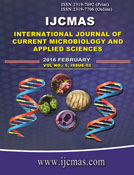


 National Academy of Agricultural Sciences (NAAS)
National Academy of Agricultural Sciences (NAAS)

|
PRINT ISSN : 2319-7692
Online ISSN : 2319-7706 Issues : 12 per year Publisher : Excellent Publishers Email : editorijcmas@gmail.com / submit@ijcmas.com Editor-in-chief: Dr.M.Prakash Index Copernicus ICV 2018: 95.39 NAAS RATING 2020: 5.38 |
Fungi found in diverse places which depends on environmental conditions and nutritional availability in the soil. Most of the fungi are saprophytic in nature, some are symbiotic and some are parasitic cause infections in plants and animals. Feather samples and soil from the selected poultry sites were collected and cultured using hair baiting technique. From hair baiting master plate the grown keratinolytic fungi were sub-cultured on sabouraud’s dextrose agar and incubated at 25-27ËšC for 3-4 days. The grown keratinolytic fungi colonies are identified microscopically by standard keys and monographs. Out of 300 samples were subjected for screening only 221 samples were found to be positive for presence of keratinolyticfungi, which were belongs to 12 species of 4 genera viz, Chrysosporium indicum (13.00%), Chrysosporium tropicum (7.33%), Chrysosporium lobatum (6.33%), Microsporum gypseum (5.67%), Microsporum nanum (5.33%), Trichophyton terrestre (5.33%), Crysosporium keratinophillum (5.00%), Trichophyton rubrum (5.00%), Trichophyton mentagrophytes (4.67%), Microsporum canis (4.67%),Trichophyton ajelloi (3.00%) and Epidermophyton floccosum (2.67%) isolated and identified. Study reveals that, Chrysosporium indicum (13.00%) was the dominant keratin degrading species in all the sampling sites, due to the well adaptation of the species for Indian climatic conditions and most of all chrysosporium species were isolated found abundant in all 10 poultry sampling sites and Among all the 10 sampling sites, Shivamogga city and Bhadravati town showed highest fungal distribution of 90% due to highest amount of keratin waste dumping.
 |
 |
 |
 |
 |